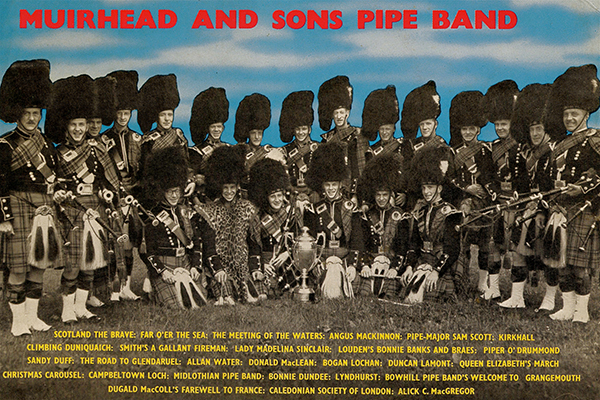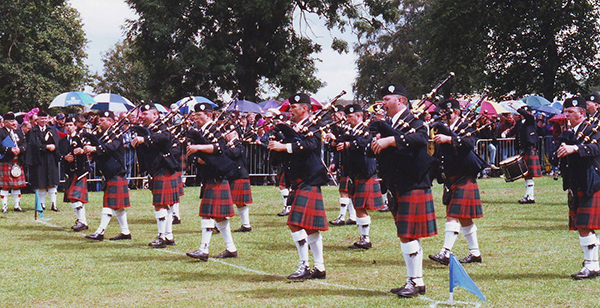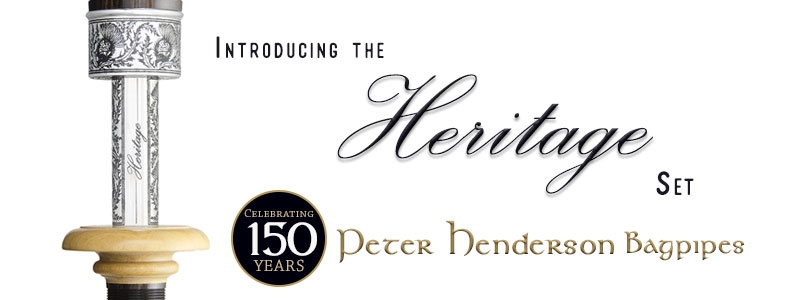This article first appeared in PIpe Band magazine in 2003. The writer was Jeannie Campbell, piping and pipe band historian.
The Second World War interrupted the pipe band contests, which were resumed in 1946. In 1947 the Association decided to take the World Championship away from Cowal as they had had a good offer from Edinburgh City Council which wanted it to be held there to coincide with the new Festival.
Cowal refused to give up the Championship or hand over the trophies and after a lot of meetings and bitter arguments the outcome was that two World Championships were held in 1947, one at Cowal, where the Glasgow Police were the winners, and the other in Edinburgh, won by Bowhill Colliery, Fife [pictured above with P/M Chris Sutherland]. The bands that played at Cowal were expelled from the SPBA and not allowed to take part in contests. Eventually the situation was resolved with the Cowal con-test continuing as a major Championship and the Association running their World Championship in various locations.
At the 1948 World Championship, which was held in Glasgow, there were contests for grades one, two and three, a contest for ladies’ bands and a contest for juvenile bands. Separate contests for ladies and juveniles were only held at the larger contests. During the 1950s pipe band associations were formed in many other parts of the world and some overseas bands visited Scotland, as for example, the City of Wellington Pipe Band from New Zealand which came to Scotland in 1958.
[wds id=”6″]From 1951 onwards judges were under cover and awarded points for intro, tone, break and execution, with comments to justify points deducted. The sheet was taken away before the next band came on. By 1955 the top grade bands at Cowal had to submit three sets of March, Strathspey and Reel and the lower grades submitted one set. In 1952 Seumas MacNeill [a writer on piping and pipe band matters] wrote that there were two ways to judge a pipe band contest. One was to sit in a tent with a stack of forms, neatly allocating points, while each band plays right next to you. The other was to submerge yourself in the crowd 50 yards away and tick off each band in the programme while carrying on an interesting conversation with your neighbour. Of the two methods, those who adopted the second were much more sure of their final placings and had even been known to be sternly critical of the results put forward by those who had adopted the first method.
In 1956 the World Championships were held in Belfast, this being the first occasion on which the championships were held outwith Scotland. A novice contest confined to Northern Ireland bands was held that year. A novice event was a regular feature of many Irish contests at that time and in the following years. At the 1957 Worlds there were two piping and one drumming judge for each grade and all bands played a march, strathspey and reel. Out of the five prize winners in Grade One, three played Abercairney Highlanders, one played Lord Alexander Kennedy and one played Dugald MacColl’s Farewell to France. Three played Dornie Ferry, one Blair Drummond and one Bob of Fettercairn. Two played Pretty Marion, one Mrs MacPherson of lnveran, one Alick C. MacGregor and one Highland Dirk.

Glen Caladh Castle and Balmoral Highlanders were popular marches in the lower grades and Dornie Ferry and the Caledonian Canal were popular strathspeys. A new points system was introduced in 1961 and in 1962 the idea of a possible fourth grade to replace the Ladies’ and Juvenile grades was broached. The question of whether judges should be under cover or in the open was being discussed at this time and in 1963 it was decided that they should be in the open. Grade Four contests began in 1963. The bands in this new grade were to ploy either a two-part march twice over or a four-part march once and have a minimum of six pipers, two sides and a bass drum.
Other grades continued to play a march, strathspey and reel. The usual system was one piping judge and one drumming judge but ensemble judges began to appear from about 1967 onwards. In 1968 there was on additional grade for Novice Juveniles. In 1969 it was decided that judges should be under cover again. At the World Championships in 1970 there were contests for Grades One, Two, Three, Four, Ladies, Juveniles and Novice Juveniles. At the 1971 RSPBA AGM it was decided that there would be Grades 1 to 4, Juvenile and Novice Juvenile. Medley selections had been tried out and were now introduced for some contests. Depending on whether the contest was for MSR or Medley, Grade One would submit either two MSRs or two selections of five to seven minutes, Grade 2 one MSR or one selection of four to six minutes, Grade 3 one MSR or one selection of three to five minutes. Grade 4 would play eight or nine parts at march tempo. Prizes for the best ladies band in each of Grades 3 and 4 replaced the Ladies only grade at the World Championships. These ladies’ prizes were continued until 1987.
By the 1970s there were several overseas bands competing at the World Championships and a special prize for the best overseas band in each grade was awarded. In the early 1970s Grade 4 bands usually played a four parted 2/4 march and when playing up to Grade 3 at the smaller contests could play the same march followed by a strathspey and reel. Some of the most popular Grade 4 tunes at the time were Muir of Ord, Hills of Alva, Hills of Perth, Duncan Macinnes, and Peter MacKenzie Warren. By 1980, two-parted 4/4 marches such as Wings, Murdo’s Wedding and Flett from Flotta were becoming popular in Grade 4.
[wds id=”2″] The traditional competition type MSRs continued but many new tunes began to appear in the medley selections. Another change at this time was the introduction of the simpler dress style for competition. In the 1970s the top bands competed in full dress, with spats, hose tops, doublets, plaids, cross belts and feather bonnets. This looked impressive but was uncomfortable for the players, especially on a hot day. By the 1980s bands were dressing for comfort and wearing black jackets, white socks and glengarries.

[wds id=”3″]



















Recent Comments